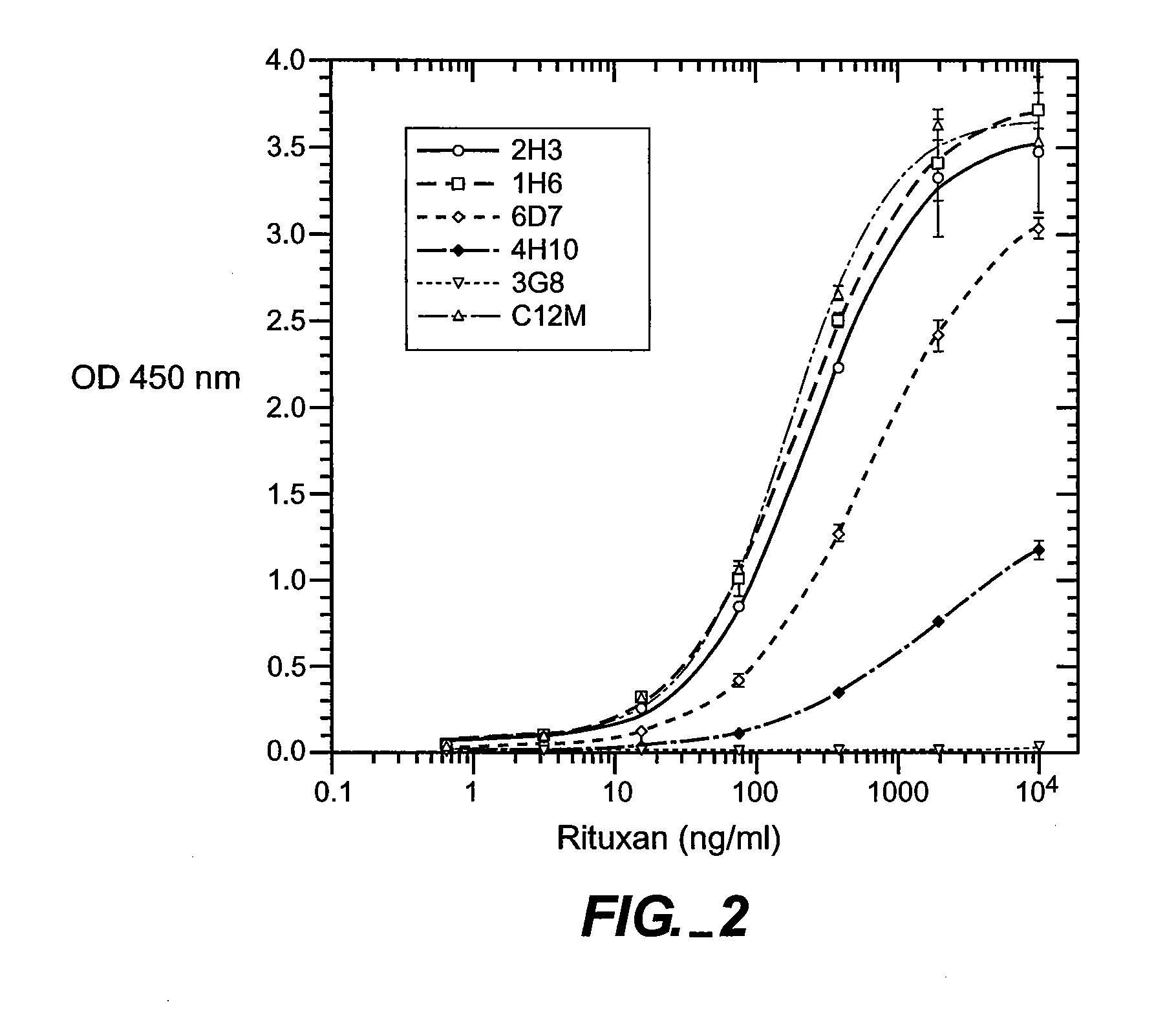Assay for Antibodies
a technology of antibodies and assays, applied in the field of highthroughput assays, can solve the problems of difficult crystallization of transmembrane proteins for x-ray structural studies, difficult expression of small extracellular loops of cd20, between two membrane-spanning regions, and usually linear, so as to reduce non-specific sticking and background, and high throughput
- Summary
- Abstract
- Description
- Claims
- Application Information
AI Technical Summary
Benefits of technology
Problems solved by technology
Method used
Image
Examples
experimental examples
III. EXPERIMENTAL EXAMPLES
[0150] The above and other features of the invention will now be described more particularly with reference to the accompanying figures and pointed out in the claims. The particular embodiments described below are provided by way of illustration and are not meant to be construed as a limitation on the scope of the invention. It will be apparent to one of ordinary skill in the art that many modifications can be made to the present invention without departing from the spirit or essential characteristics of the invention. The following examples are intended to illustrate embodiments now known for practicing the invention, but the invention is not to be considered limited to these examples. The disclosures of all citations herein are expressly incorporated by reference.
example 1
Materials and Methods
Anti-CD20 Antibody
[0151] Full-length chimeric antibody and humanized anti-CD20 antibody variants were generated from a mouse anti-human CD20 antibody using a human IgG1, framework at Genentech, Inc. They were expressed in 293 cells and purified using a protein A column as described previously (Presta et al., Cancer Res., supra). See FIGS. 6A and 6B for the amino acid sequences of the respective light-and heavy-chain variable domains (VL and VH) of the parent murine antibody, humanized variant h2H7.v16 (SEQ ID NO: 12), and the human kappa light chain of subgroup I or the human consensus sequence of heavy-chain subgroup III.
CD20-Expressing CHO Clones
[0152] Human CD20 cDNA (Genentech, Inc.) was subcloned into a modified dihydrofolate reductase (DHFR) intron vector at the SpeI site as described in Meng et al., Gene, 242: 201-207 (2000). CHO K1 DUX B 11 (DHFR-) cells (Columbia University) were grown in 50:50 F12 / DMEM medium supplemented with 2 mM L-glutamine, ...
example 2
[0166] An ELISA as set forth in Example 1 can be employed to detect antibodies to a chemokine receptor. This would be useful, for example, to detect humanized antibodies to a chemokine receptor in a clinical sample, where the humanized antibodies are administered to clinical patients to treat a chemokine-mediated disorder. Thus, anti-idiotypic monoclonal antibodies are generated to murine MAb LS 132.1D9 (1D9) or to a humanized antibody that can compete with 1D9 for binding to human CCR2 as described in U.S. Pat. No. 6,696,550, by injecting 0.5 μg of 1D9 or the humanized antibody formulated in monophosphoryl lipid A / trehalose dicorynomycolate adjuvant (Corixa, Hamilton, Mont.) into the footpads of Balb / c mice (Charles River Laboratories, Wilmington, Del.) eleven times. Popliteal lymph nodes from mice with high titers are fused with P3X63Ag.U.1 myeloma cells (American Type Culture Collection (ATCC, Manassas, Va.)). Hybridoma cells producing antibodies with binding affinity for 1D1 or ...
PUM
 Login to View More
Login to View More Abstract
Description
Claims
Application Information
 Login to View More
Login to View More - R&D
- Intellectual Property
- Life Sciences
- Materials
- Tech Scout
- Unparalleled Data Quality
- Higher Quality Content
- 60% Fewer Hallucinations
Browse by: Latest US Patents, China's latest patents, Technical Efficacy Thesaurus, Application Domain, Technology Topic, Popular Technical Reports.
© 2025 PatSnap. All rights reserved.Legal|Privacy policy|Modern Slavery Act Transparency Statement|Sitemap|About US| Contact US: help@patsnap.com



